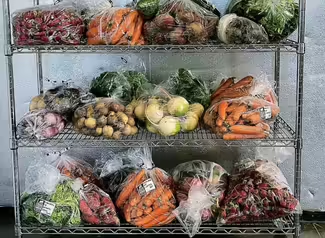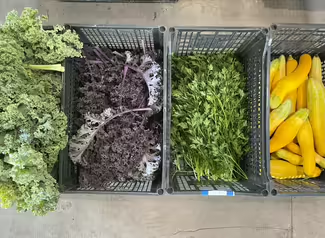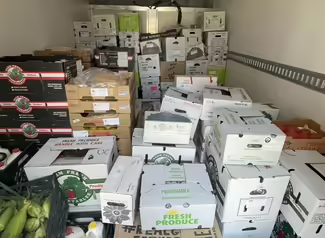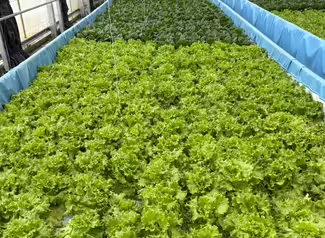
Every Tuesday, Tony Stirling of Valley Fresh Harvest hauls 150 pounds of lettuce from his hydroponic operation in Ladd to the Down at the Farms warehouse near Fairbury. Down at the Farms coordinates its sale to restaurants, schools, and other wholesale and retail outlets. In addition, some lettuce is distributed to food access organizations.
Once unloaded, Tony, whose farm operation also serves as one of the group’s four outbound charitable food distribution hubs, repacks his truck with food provided by other Down at the Farms farmers and takes it to communities in his area facing food access challenges. His efforts serve about 175 families a month.
Filling the gap
Down at the Farms partners with about 120 farmers, connecting high-quality products from family farmers in the region with chefs, restaurants, corporate kitchens, prescription food programs, and Community Supported Agriculture box programs. Each cooperating farm uses organic, regenerative growing practices that build soil health through non-toxic, biological farming systems.
“Our farmers are committed to producing good food with exceptional nutrient density,” says Natalie Ward, marketing communications liaison. “We strive to nourish not only the body but the communities we’re working in as well.”

“Farmers want to focus on doing what they enjoy — farming,” Natalie says. Down at the Farms finds a market for the crops, eliminating a lot of stress for family farmers while expanding their sales reach.
“Illinois has rich soil and plenty of people that are in love with growing quality food,” Natalie says. Down at the Farms acts as a bridge to markets, from small locations to Chicago’s finest dining.
“In today’s food environment, there’s value in knowing where their food is coming from,” Natalie added.
In addition to building a network of chefs and restaurateurs who purchase the often-unique specialty crops, such as violets, tree blossoms, and juniper branches, Down at the Farms is using its network to secure and distribute locally grown food to individuals in communities facing food insecurity and limited food access.
Natalie: ‘Healthy bodies, healthy minds, healthy spirits’
In June 2024, Down at the Farms expanded its food access work through a new partnership with IL-EATS. This USDA Local Food Purchase Assistance Program provides states with funding to purchase high-quality food from local producers and distribute it at no cost to underserved communities. In Illinois, it operates as IL-EATS and is coordinated by the Illinois Department of Agriculture, Illinois Department of Human Services, and Illinois Extension.
Food purchased using IL-EATS funds is distributed through hubs, like those operated by Tony Sterling, in Ladd, Benson, Pembroke, and Peoria. The hubs were created in anticipation of additional funding and will be supported for long-term use once the program expires.
Nearly half of the 120 Down at the Farms farmers have sold products through the IL-EATS program. 65% of those farmers have been in operation for less than 10 years and are considered new farmers by the USDA; 61% of their IL-EATS farmers are female-owned businesses.
Because of their involvement with IL-EATS, Down at the Farms now contributes about 6,000 pounds of food valued at $30,000 each week to families in communities served by its four satellite hubs. It also provides about 48,000 pounds of food a year to the Midwest Food Bank.

The farmers that Down at the Farms works with responded by building infrastructure and increasing production to meet the new demand afforded by IL-EATS. The funding has been lifesaving.
“IL-EATS allowed us to survive,” Tony says. “We were having a hard time moving product; it’s just hard to break into the grocery store market.”
Grocery outlets often have large contracts with national distributors.
IL-EATS allowed him to receive a good price for his produce while supporting the nutritional needs of people in his region who need it most. Tony says it’s rewarding to meet and talk to people who are eating the food he and others produce.
One of his distribution sites is home to several families who lost their jobs unexpectedly when a large employer shut down. Many tell Tony they rarely eat high-quality and flavorful food like that provided by IL-EATS growers.
Value in an aggregation system
There’s no need for Down on the Farms to advertise; good news spreads fast. Just four years ago, their farm network included only 50 farm operations. After more than doubling the number of farms they work with, Down at the Farms has expanded into a larger distribution building.
More specialty crop growers are tapping into the benefits of food aggregation systems, Tony says. Unfortunately, IL-EATS’ involvement with Illinois producers and partners will end September 30, following a USDA decision to cancel the additional year of funding promised during the Biden administration.
“I wish there were more ways to help the small farmer and help the local community members at the same time,” Tony says. “Without IL-EATS, I don’t know how many of us will survive the next six months.”



